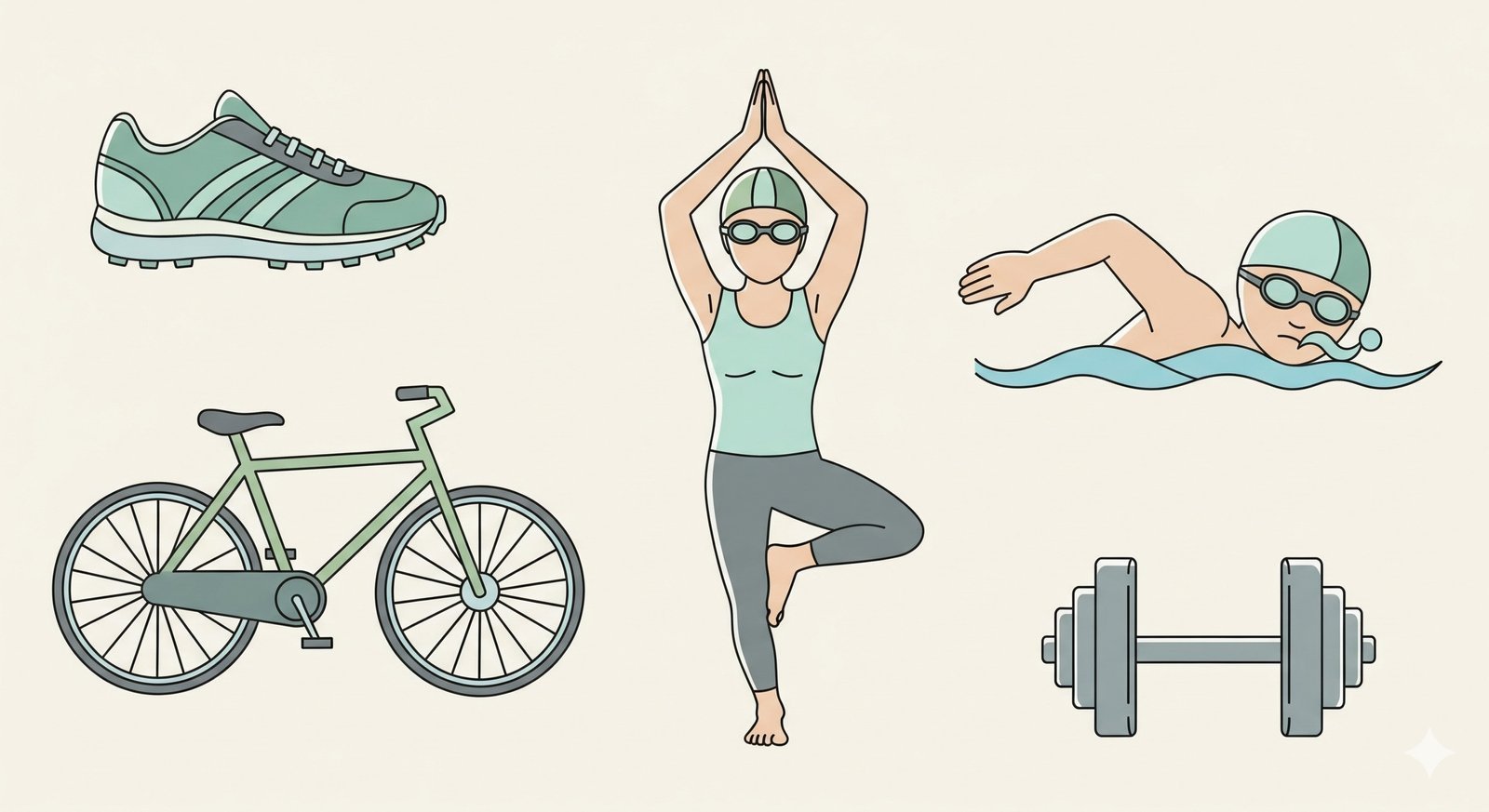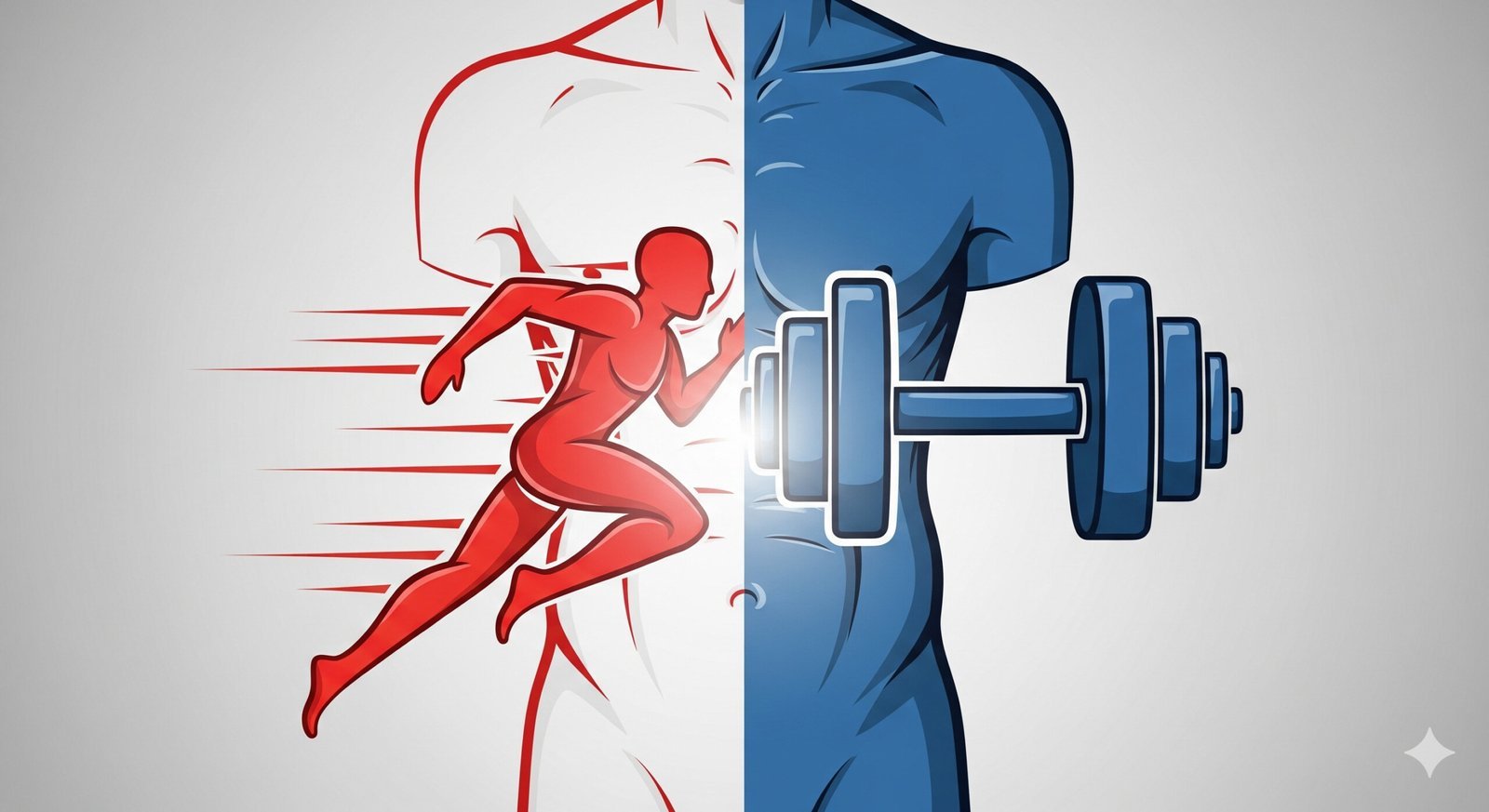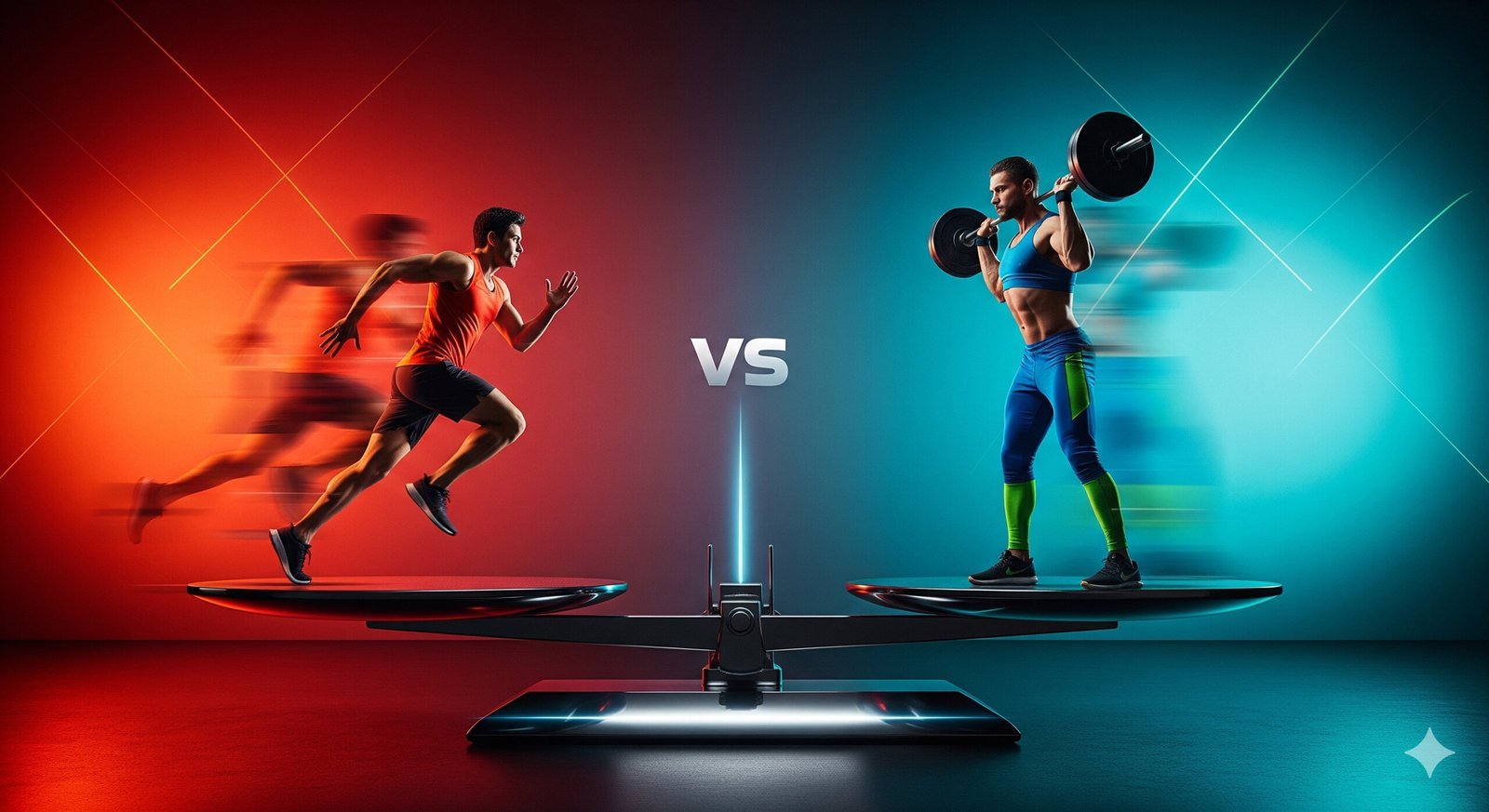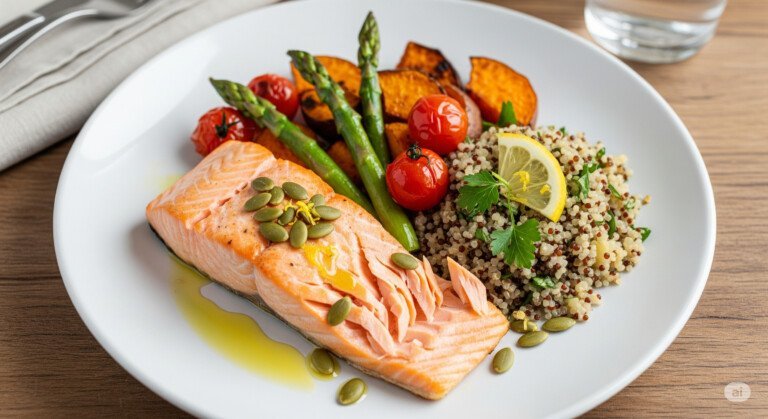Your Biggest Question: Weight Lifting vs Cardio
For decades, the fitness world has been divided into two camps: those who swear by the treadmill and those who live in the weight room. When the goal is to shed pounds, the question of cardio vs strength training for weight loss is often the first one people ask. Should you pound the pavement for hours, or is lifting heavy weights the true secret to a leaner physique? The answer is more complex than you might think, and understanding the science behind each type of exercise is the key to unlocking your body’s true potential.
Thank you for reading this post, don't forget to subscribe!This guide will settle the debate once and for all. We’ll explore how each workout style affects your metabolism and body composition, and we’ll reveal the undeniable truth about which one is better for burning fat. By the end, you’ll have a clear understanding of the roles of weight lifting vs cardio and how to combine them for maximum results.


Running, Cycling, Or Both? The Best Cardio for Fat Loss
Cardio, or aerobic exercise, is synonymous with fat burning in many people’s minds. It’s the exercise we perform for an extended period at a moderate intensity, raising our heart rate and getting our blood pumping. The most common forms are running, cycling, swimming, and using the elliptical. The benefit is straightforward: it burns calories while you’re doing it.
However, the question of what is the best cardio for fat loss isn’t just about calorie burn. It’s about a few other key factors:
- Calorie Burn During Exercise: During a cardio session, your body uses both stored carbohydrates and fat for energy. The longer and more intense the session, the more calories you burn. This makes cardio an excellent tool for creating a calorie deficit, which is the foundation of all weight loss.
- Metabolic Rate: While cardio burns a significant number of calories during the workout, its effect on your metabolism afterward is generally short-lived.
- Accessibility: Cardio is often more accessible to beginners. A walk, a jog around the block, or a session on a stationary bike requires less specialized equipment and knowledge than weight training.
Different forms of cardio offer different benefits. Steady-state cardio, like a long, brisk walk, is great for a sustained calorie burn. High-Intensity Interval Training (HIIT), on the other hand, involves short bursts of intense effort followed by brief recovery periods. While a HIIT session is shorter, its effect on your metabolism can last for hours afterward, a phenomenon known as EPOC (Excess Post-exercise Oxygen Consumption).
The Science of EPOC: After a challenging workout, your body continues to burn calories at an elevated rate to recover. This “afterburn” effect is much more pronounced with high-intensity exercise like HIIT than it is with steady-state cardio. This is one of the main reasons why a shorter, more intense workout can sometimes lead to greater overall fat loss.


The Fear: Does Cardio Really Burn Muscle?
One of the most common fears among those who lift weights is that doing too much cardio will cause them to lose muscle mass. The question of “Does cardio burn muscle?” is a valid concern, and it has a nuanced answer.
The short answer is: yes, it can, but it is not a given. Your body is incredibly efficient. If you perform a very long, very intense cardio session and you haven’t consumed enough calories, your body may turn to muscle tissue for energy. This is a catabolic process that can happen in the absence of an adequate fuel source.
However, for most people, this is not a major concern. If you consume enough protein and calories, a reasonable amount of cardio (30-60 minutes, 3-5 times per week) will not significantly impact your muscle mass. In fact, a moderate amount of cardio can even be beneficial for muscle-building by improving blood flow and aiding in recovery. The real key is balance and proper nutrition.
The biggest takeaway here is that you don’t have to choose one over the other. The best approach is to find a healthy balance that works for your body and your goals.


Winning the Battle: Cardio vs Weights for Belly Fat
When it comes to the frustrating quest to get rid of abdominal fat, the debate of cardio vs weights for belly fat is a heated one. Many believe that endless crunches and long runs are the only way to a flat stomach, but the truth is a little different.
The concept of “spot reducing” fat is a myth. You cannot choose where your body burns fat from. Fat loss occurs over your entire body, and genetics determine where you lose it from first. However, both cardio and weights are powerful tools for general fat loss.
- Cardio: Cardio is excellent for burning calories and creating the necessary calorie deficit to lose fat all over.
- Strength Training: While it may not burn as many calories in a single session, strength training is far more effective at building muscle. As we’ve discussed, muscle is metabolically active, meaning it burns more calories at rest. This leads to a higher metabolism and a body that is a more efficient fat-burning machine 24/7.
The most effective strategy for losing belly fat is a combination of both. You need cardio to burn calories and a calorie deficit, and you need strength training to build muscle and increase your resting metabolism. When these two are combined, you create a powerful, sustainable fat-loss strategy.


Ignite Your Burn: The Fat Burning Cardio Workout
While all cardio can burn fat, not all cardio is created equal. The ultimate fat burning cardio workout is one that is both efficient and sustainable. High-Intensity Interval Training (HIIT) is one of the most effective methods.
A typical HIIT workout involves:
- A short warm-up (5 minutes)
- A period of high-intensity exercise (e.g., all-out sprint for 30 seconds)
- A period of active rest (e.g., walking for 90 seconds)
- Repeat for 15-20 minutes
- A cool-down (5 minutes)
HIIT workouts are short, but the “afterburn” effect, known as EPOC, means you continue to burn calories for hours after you finish. This makes it incredibly effective for fat loss. Other forms of cardio, like a long, brisk walk, are also excellent for fat burning because they are low-stress and can be done for a long duration, leading to a high total calorie burn.


Where to Begin: A Simple Cardio Plan for Beginners
If you are just starting your fitness journey, the idea of doing a HIIT workout or a long run might seem intimidating. But every expert was once a beginner. The key to success is creating a realistic and sustainable cardio plan for beginners.
- Start with Walking: A brisk walk is a fantastic way to start. It’s low-impact, great for your heart, and can be done anywhere. Aim for 20-30 minutes, 3-4 times a week. Once you are comfortable, you can increase your speed or distance.
- Gradual Progression: Don’t go from zero to 100. Start with 20 minutes of walking, three times a week. Each week, you can increase your time or intensity.
- Listen to Your Body: Don’t push yourself to the point of injury. Pay attention to how you feel and take rest days when you need them.
- Variety is Key: Try different forms of cardio to keep things interesting. You could try cycling one day and a dance workout the next. Consistency is more important than perfection.
The most effective workout is the one you will actually do.


The Synergy of Weights and Cardio for Fat Loss
The truth is, it’s not a debate. The most effective strategy for sustainable fat loss is to combine the power of both. When you put cardio vs strength training for weight loss head-to-head, you’re missing the point. They aren’t opponents; they are teammates.
- Cardio for Calorie Deficit: Cardio is your primary tool for burning calories and creating the deficit needed for weight loss.
- Strength Training for Metabolism: Strength training is your long-term strategy for building a more efficient, fat-burning body. It increases your resting metabolism, so you burn more calories even on your rest days.
A great approach is to incorporate both into your weekly routine. You could do a weight training session in the morning and a cardio session in the evening, or dedicate separate days to each. The goal is to find a routine that works for your schedule and your body.


Your Journey to Unstoppable Fat Loss
The question of cardio vs strength training for weight loss is a powerful one, but the real answer lies in a simple truth: they both play a vital role. By combining the immediate calorie burn of cardio with the long-term metabolic boost of strength training, you create a powerful synergy that will help you not only lose fat but build a stronger, healthier, and more resilient body.
FAQ
1: What is more effective for overall health
Both are crucial for overall health. Cardio is vital for heart health, while strength training is essential for bone density and muscle mass. A combination of both provides the most comprehensive health benefits.
2: Will I get bulky from lifting weights?
No, gaining significant bulk from lifting weights is extremely difficult and requires a specific diet and training regimen. For most people, strength training will result in a leaner, more toned physique.
3: Should I do cardio or strength training first?
It depends on your goal. If your primary goal is to build muscle, do strength training first. If your primary goal is to improve your endurance, do cardio first. If you want to burn fat, you can do them on separate days to maximize your energy for each.
4: Can I lose weight with just cardio?
Yes, you can. However, you will likely lose both fat and muscle, and your metabolism will slow down. Combining cardio with strength training is a more effective and sustainable strategy for long-term fat loss.
5: How many times a week should I do both?
A good starting point is 2-3 days of strength training and 2-3 days of cardio per week. You can adjust this based on your schedule and fitness level.
Disclaimer:
This post may contain affiliate links. If you purchase through them, we may earn a small commission at no extra cost to you. Also, this content is for informational purposes only and does not substitute professional medical advice.







